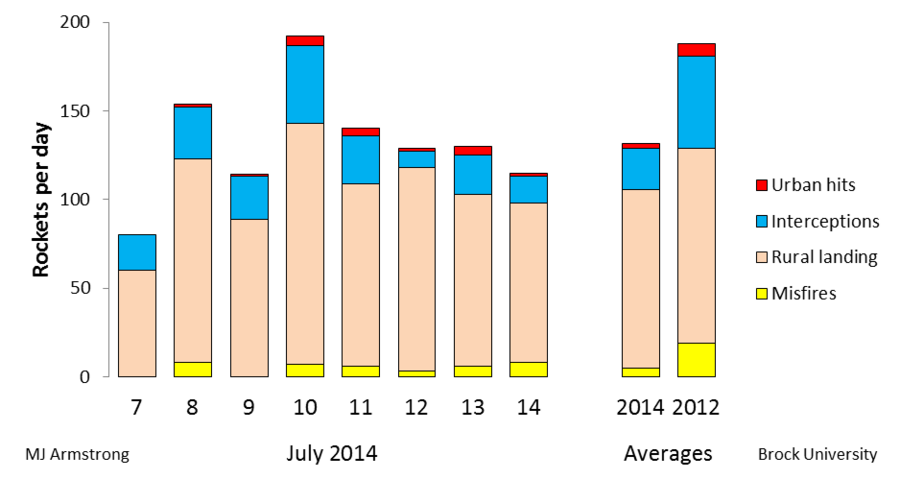Gaza militants' rockets: Fewer, less accurate than last Hamas-Israel conflict
Loading...
A popular narrative about the current face-off between Hamas and other Palestinian militants in the Gaza Strip and Israel is that the Israelis, confronted with withering volleys of rocket fire, have had no choice but to respond with overwhelming force and that the failure of the rockets to do much damage has largely been thanks to the country's US-funded Iron Dome missile defense system.
But it turns out that compared to the last major escalation between the two sides, the Palestinians in 2014 are firing fewer rockets than in the past, and those rockets they are firing are proving less accurate.
And as for Israeli claims that Iron Dome has destroyed 90 percent of the rockets it has targeted and that it's a "game-changer," an MIT professor is deeply skeptical.
Israel promised an increased bombing campaign on Gaza today after a proposal that Hamas stop rocket fire in exchange for returning to the status quo was turned down by the group's military leadership. Israel blanketed an area around the town of Jabalya in northern Gaza today with leaflets warning roughly 100,000 residents to flee or else face death. Jabalya began as a refugee camp for Palestinians who fled villages in what was to become southern Israel in 1948.
When the shooting started this time, after a major Israeli roundup of hundreds of Hamas activists in the West Bank in response to the murder of three teens, Israeli officials asserted that the rocket stockpile in Gaza had grown more powerful and accurate. Based on the evidence of the past few weeks, "more accurate" does not seem an apt description.
Michael Armstrong is a professor at Canada's Brock University who uses mathematical models to measure risk in complex systems and has studied naval missile warfare and land-based missile defense systems. He crunched the numbers based on Israel Defense Forces (IDF) reporting on rocket launches and interceptions in 2012 during Operation Pillar of Defense and this year during Israel's Operation Protective Edge. He concludes that fewer rockets are being fired this time from Gaza, that they're less accurate, and being intercepted less often by Iron Dome than in 2012.
In an email, he summarizes his findings:
"The attacks are averaging 132 rockets per day, about 30% less than the average rate of 188 in 2012. This partially may be due to them firing more from underground and hidden sites. The rocket fire is less accurate. About 20% of the rockets hit urban areas or are intercepted beforehand, about 1/3 less than the 31% of 2012. This partially may be due to the longer ranges some are traveling.... There are only half as many hits on urban areas per day. This is because the rockets are less numerous and less accurate, while the interception rate is steady."
He provided a chart which compares the current action to Israel's Operation Pillar of Defense in November 2012. In the current conflict, which began on July 7, 178 Palestinians have been killed and one Israeli. The UN estimates that 138 of the dead are civilians, 36 of them children.
Iron Dome doesn't target all rockets fired towards Israel. Since each interceptor costs around $60,000 and many of the crude rockets fired by Hamas and others from Gaza cost as little as $1,000, that would be a quick way to go bankrupt. Instead, radar picks up the trajectory of rockets, and only fires at ones headed for population centers. So the lower rate of interceptions by Israel in Amrstrong's analysis (a chart of his can be found along the right-hand column of this page) at least in part reflects the lower degree of accuracy in this round of fighting.
Hamas missile teams have been forced by Israeli counteraction to fire from further away than in previous conflicts, and they appear to be firing from positions that are at least partially below ground, making the calculations for aiming the crudely-directed rockets more difficult. In all, Israel says about 1,500 rockets had been fired at Israel through yesterday. Israeli air strikes have destroyed about 1,160 targets in Gaza so far.
Is Iron Dome to credit for the discrepancy? That Iron Dome is overwhelmingly effective has become an article of faith for many Israelis and the programs backers in Congress. But Theodore Postol at MIT disagrees. An earlier piece in the MIT Technology Review quoting Dr. Postol saying Iron Dome has been largely ineffective led to a flood of furious complaints, prompting the piece he released last night. Reaction "was so negative, and angered so many people, particularly Israelis, that we asked Professor Postol to explain how he came to his conclusions and to show his data," the publication's editors wrote.
Postol, a physicist and missile defense expert, has long taken aim at overheated missile defense claims (his 1991 debunking of the Patriot missile defense system's effectiveness against Iraqi Scuds aimed at Israel during the First Gulf War similarly infuriated the Pentagon).
He writes that examination of photographs showing contrails of attempted interceptors shows few head-on hits – in his estimation just 5 percent of the time. He argues that absent such hits, the system is not performing as advertised.
One of the most demanding problems in intercepting an artillery rocket is that the interceptor must destroy the warhead on the rocket. If the interceptor hits the back end of the rocket, all that will happen is damage to the expended rocket motor tube, which is basically an empty pipe. Damaging the back end of the artillery rocket essentially has no effect on the outcome of the engagement. The pieces of the rocket will essentially fall in the same defendant area, and the warhead will almost certainly go on to the ground and explode. These facts mean that the only meaningful definition of a successful intercept is the destruction of the artillery rocket warhead. As will be shown in the discussion to follow, destroying the artillery rocket warhead is considerably more demanding than doing damage to other parts of the artillery rocket—or successfully damaging an aircraft, causing the failure of its mission.
He says that rather than Iron Dome, the explanation for low Israeli casualties is the small size of the explosives in the rockets and an excellent Israeli early warning system and network of bomb shelters. The argument is of more than academic interest. The US has spent $721 million on the system for Israel since 2011 and yesterday a Senate subcommittee voted to roughly double spending on the program to $350 million in the next fiscal year. Postol argues this is wasted money, since the payloads of Gaza rockets are so small (from 1-2 pounds up to about 30 pounds of explosives against 1,000 pounds or more in Israel's bombs) they can't harm bunkers (bunkers would be much less effective against serious artillery such as is in Israel's arsenal).
"This illustrates that the small size of the artillery rocket warheads and the ability to quickly warn populations of these arriving small warheads is an extremely capable defense that works far more effectively than Iron Dome," he writes.
(This story was corrected after posting because it misidentified Israel's name for its 2012 Gaza offensive.)








